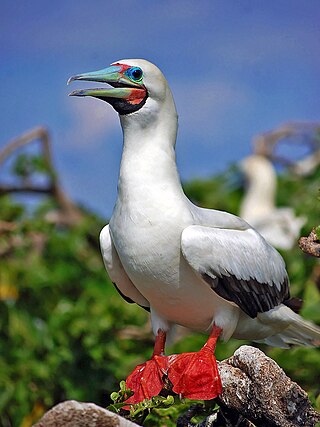
The red-footed booby is a large seabird of the booby family, Sulidae. Adults always have red feet, but the colour of the plumage varies. They are powerful and agile fliers, but they are clumsy in takeoffs and landings. They are found widely in the tropics, and breed colonially in coastal regions, especially isolated islands such as St. Brandon, Mauritius. The species faces few natural or man-made threats, although its population is declining; it is considered to be a least-concern species by the International Union for Conservation of Nature (IUCN).

The Tanna ground dove, also known as Forster's dove of Tanna, is an extinct dove species. Its taxonomic affiliation is uncertain but at its first scientific discussion by Johann Georg Wagler in 1829 it was classified into the genus Gallicolumba ; its closest relative is possibly the Santa Cruz ground dove. It was endemic to the Pacific island of Tanna, Vanuatu. Forster records a native name mahk, almost certainly from the Kwamera language.
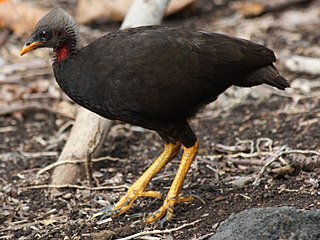
The Micronesian megapode or Micronesian scrubfowl is an endangered megapode which inhabits islands of the Western Pacific Ocean.
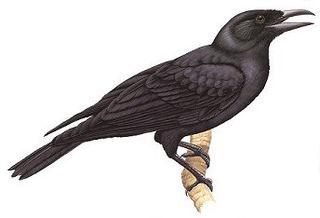
The Mariana crow is a species of the crow family from the tropical Western Pacific. It is a glossy black bird about 15 inches (38 cm) long and known only from the islands of Guam and Rota.
The Mariana swiftlet or Guam swiftlet is a species of swiftlet in the family Apodidae.

The island bronze-naped pigeon, also known as the São Tomé bronze-naped pigeon or São Tomé pigeon, is a species of bird in the pigeon family, Columbidae. It is endemic to the Gulf of Guinea, where it is found on the islands of São Tomé, Príncipe, and Annobón. It inhabits rainforest, secondary forests, and plantations at elevations of up to 1,668 m (5,472 ft), although it is more common at lower elevations. A small, darkish pigeon, it has a total length of 28 cm (11 in). Adult males have slate-grey heads and upper backs, blackish-grey wings, backs, and tails, buffy-white throats, ashy-grey breasts and bellies, and rufous vents. The back of the neck and upper back are glossy pink or green, while the wings have a green tinge to them. Females are similar, but have browner undersides, duller and less glossy upperparts, and more rusty-orange outer tail feathers.
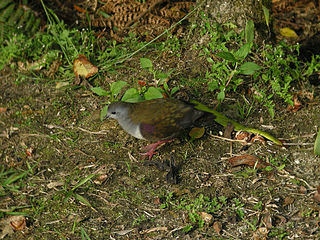
The bronze ground dove is a species of bird in the family Columbidae.

The Palau ground dove is a species of bird in the family Columbidae. It is endemic to Palau, living in forests. The IUCN has assessed it as an endangered species.

The Polynesian ground dove or Society Islands ground dove or Tutururu is a critically endangered species of bird in the family Columbidae. Originally endemic to the Society Islands and Tuamotus in French Polynesia, it has now been extirpated from most of its former range by habitat loss and predation by introduced species such as cats and rats, and the species is now endemic only in the Acteon islands. The total population is estimated to be around 100-120 birds.
The Wetar ground dove is a species of bird in the family Columbidae found on Wetar, Indonesia, and on Timor. Its natural habitats are monsoon forests and gallery forests, and possibly woodland and bamboos. Threatened by habitat loss and hunting, the species is assessed as endangered by the IUCN.

The white-breasted ground dove, white-bibbed ground dove, or purple ground dove is a species of bird in the family Columbidae. It is found in New Guinea, the Bismarck Archipelago and the Solomon Islands. Its natural habitats are subtropical or tropical moist lowland forest and subtropical or tropical moist montane forest.

The white-fronted ground dove or Caroline Islands ground dove is a species of bird in the family Columbidae. It is endemic to Micronesia.

The Norfolk ground dove was a species of bird in the Columbidae, or pigeon family.
The Marquesan ground dove or Marquesas ground dove is a bird species in the family Columbidae. It is endemic to French Polynesia. Its natural habitats are subtropical or tropical dry forests and subtropical or tropical moist shrubland.
The Santa Cruz ground dove is a species of bird in the family Columbidae. It is found in the southern Solomon Islands and Vanuatu. Its natural habitat is subtropical or tropical moist lowland forests. It is threatened by habitat loss.

The Tongan ground dove, also known as the shy ground dove or friendly ground dove, is a species of bird in the family Columbidae. It is found in American Samoa, Fiji, Samoa, Tonga and Wallis and Futuna Islands. Its natural habitat is subtropical or tropical moist lowland forests. It is threatened by habitat loss.
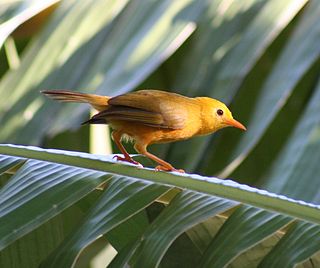
The golden white-eye is a species of bird in the white-eye family, Zosteropidae. It is the only species within the genus Cleptornis. The golden white-eye was once considered to be a honeyeater in the family Meliphagidae and although it is now known to be a white-eye, its position within that family is still uncertain. The species is restricted to the islands of Saipan and Aguijan in the Northern Mariana Islands, where it is sympatric and competes with the related bridled white-eye. The golden white-eye has golden plumage and a pale eye-ring. It feeds on insects, fruit, and nectar and forages in pairs or small family groups. The bird is monogamous and lays two eggs in a small cup nest.

The Philippine collared dove is a species of bird in the family Columbidae. It was formerly considered a subspecies of the island collared dove.

Pampusana is a mid-sized genus of ground-dwelling doves which occur in rainforests in the Pacific region. They are not closely related to the American ground doves.
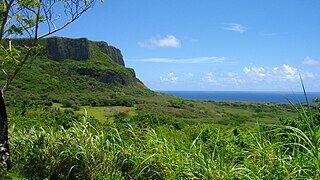
The Marianas tropical dry forests is a tropical and subtropical dry broadleaf forests ecoregion on the Marianas Islands in the western Pacific Ocean.
















